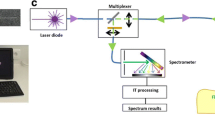Abstract
Fine-needle aspiration cytology is the standard technique to diagnose thyroid pathologies. However, this method has a high percentage of inconclusive and false-negative results for benign and malignant lesions. Hence, it is important to search for a new method to assist medical evaluation during these surgical procedures. The use of time-resolved fluorescence techniques to detect biochemical composition and tissue structure alterations could help to develop a portable, minimally invasive, and non-destructive method to assist medical evaluation. In this study, we investigated 17 human thyroid samples by absorbance, fluorescence, excitation, and time-resolved fluorescence measurements. This initial investigation has demonstrated that thyroid fluorescence originates from many endogenous fluorophores and culminates in several bands. The fluorescence lifetimes of benign and malignant lesions were significantly different, as attested by analysis of variance using Tukey test with individual confidence level of 98.06 %. Our results suggest that fluorescence lifetimes of benign and malignant lesions can potentially assist diagnosis. After further investigations, fluorescence methods could become a tool for the surgeon to identify differences between normal and pathological thyroid tissues.




Similar content being viewed by others
References
Rout P, Shariff S (1999) Diagnostic value of qualitative and quantitative variables in thyroid lesions. Cytopathology 10(3):171–179
Teixeira CS et al (2009) Thyroid tissue analysis through Raman spectroscopy. Analyst 134(11):2361–2370
Zhang X et al (2011) Intraoperative detection of thyroid carcinoma by Fourier transform infrared spectrometry. J Surg Res 171(2):650–656
Gupta N et al (2011) Evaluation of the role of magnetic resonance spectroscopy in the diagnosis of follicular malignancies of thyroid. Arch Surg 146(2):179–182
Suh H et al (2011) Elastic light-scattering spectroscopy for discrimination of benign from malignant disease in thyroid nodules. Ann Surg Oncol 18(5):1300–1305
Chen X et al (2012) Quantitative analysis of collagen change between normal and cancerous thyroid tissues based on SHG method. Proc SPIE 8329:83290H
Zhou C et al (2010) Ex vivo imaging of human thyroid pathology using integrated optical coherence tomography and optical coherence microscopy. J Biomed Opt 15(1):016001–1–016001–9
Pitman MJ et al (2004) The fluorescence of thyroid tissue. Otolaryngol Head Neck Surg 131(5):623–627
Ebenezar J et al (2012) Noninvasive fluorescence excitation spectroscopy for the diagnosis of oral neoplasia in vivo. J Biomed Opt 17(9):97007–1
Giubileo G et al (2005) Fluorescence spectroscopy of normal and follicular cancer samples from human thyroid. Spectrosc 19(2):79–87
Paras C et al (2011) Near-infrared autofluorescence for the detection of parathyroid glands. J Biomed Opt 16(6):067012–1–067012–4
Uehlinger P et al (2009) In vivo time-resolved spectroscopy of the human bronchial early cancer autofluorescence. J Biomed Opt 14(2):024011
Berezin MY, Achilefu S (2010) Fluorescence lifetime measurements and biological imaging. Chem Rev 110(5):2641–2684
Marcu L (2012) Fluorescence lifetime techniques in medical applications. Ann Biomed Eng 40(2):304–331
Chan E, Menovsky T, Welch AJ (1996) Effects of cryogenic grinding on soft-tissue optical properties. Appl Optics 35(22):4526–4532
Bachmann L et al (2006) Fluorescence spectroscopy of biological tissues—a review. Appl Spectrosc Rev 41(6):575–590
Chorvat D Jr, Chorvatova A (2009) Multi-wavelength fluorescence lifetime spectroscopy: a new approach to the study of endogenous fluorescence in living cells and tissues. Laser Phys Lett 6(3):175–193
Rayner DM, Szabo AG (1978) Time resolved fluorescence of aqueous tryptophan. Can J Chem 56(5):743–745
Engelborghs Y (2001) The analysis of time resolved protein fluorescence in multi-tryptophan proteins. Spectrochim Acta 57(11):2255–2270
Goldman C, Pascutti PG, Piquini P, Ito AS (1995) On the contribution of electron transfer reaction to the quenching of tryptophan fluorescence. J Chem Phys 103:10614–10620
Platten M, Wick W, Van den Eynde BJ (2012) Tryptophan catabolism in cancer: beyond IDO and tryptophan depletion. Cancer Res 72(21):5435–5440
Opitz CA et al (2011) An endogenous tumour-promoting ligand of the human aryl hydrocarbonreceptor. Nature 478(7368):197–203
Liu X et al (2010) Selective inhibition of IDO1 effectively regulates mediators of antitumor immunity. Blood 115(17):3520–3530
Acknowledgments
The authors would like to acknowledge Universidade de São Paulo – USP, Fundação de Amparo à Pesquisa do Estado de São Paulo – FAPESP (Projects number 2011/07960-4 and 2012/02460-6), and Conselho Nacional de Desenvolvimento Científico e Tecnológico – CNPq (Project number 160014/2012-3) for the grants and fellowships given to this research. The authors thank Cynthia Maria de Campos Prado Manso for linguistic advice.
Author information
Authors and Affiliations
Corresponding author
Rights and permissions
About this article
Cite this article
Brandao, M.P., Iwakura, R., Basilio, F.S. et al. Optical Characterization of Normal, Benign, and Malignant Thyroid Tissue: A Pilot Study. J Fluoresc 25, 465–471 (2015). https://doi.org/10.1007/s10895-015-1542-0
Received:
Accepted:
Published:
Issue Date:
DOI: https://doi.org/10.1007/s10895-015-1542-0




